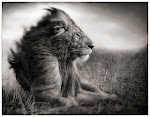
I have a list, of creatures in the world that not only scare me, but inspire a sense of terror for whatever reason. Ironically, this is the same list as the list of creatures I want to spend time with. Maybe someday I'll get around to posting the list, but right now, I'd just like to address one: polar bears.
Polar bears are huge, the largest land predator of today. They weigh in between1,000 and 1,500 pounds, on average. They blend in so well with their environment that they might as well be giant ninjas, and they don't fear humans. This last is startling. Most mammals are skittish of human settlements, but in many areas polar bears acquire a taste for garbage, and sometimes for humans themselves. They're one of the rare predators that have been known to actively hunt humans. And we're just beginning to learn about their origins.
In Norway 2004, a rare fossil of a polar bear jaw was discovered, and it may hold secrets as to not only the age and origins of the species, but also the ability of polar bears to adapt to climate change.
“Our results confirm that the polar bear is an evolutionarily young species that split off from brown bears some 150,000 years ago and evolved extremely rapidly during the late Pleistocene, perhaps adapting to the opening of new habitats and food sources in response to climate changes just before the last interglacial period,” says Charlotte Lindqvist, research assistant professor in the University at Buffalo Department of Biological Sciences.
The age of the fossil implies that polar bears are a relatively new species, off-shooting from their closest relatives, the brown bear. Ironically, this fossil that tells us the polar bear is young is also "the oldest mammal mitochondrial genome to be sequenced." It's nearly twice as old as the oldest mammoth genome yet sequenced.
The term "mitochondrial genome" refers to all the DNA in the mitochondrion, the energy-producing component of most complex beings. Think of them as midichlorians, giving energy to living beings. The polar bear is a Jedi Knight. Polar bears with lightsabers...frightening.
The fossil also shows that polar bears have survived other climate changes, including interglacial warming periods. This may seem to be a point against global warming arguments, but the rapidity of this current climate change may be too much for the polar bears. We don't know if they can keep up.
Yes, they terrify me. But if they disappear, I'll never get the chance to face one in its home environment. And that makes me terribly sad.
Full Article









No comments:
Post a Comment